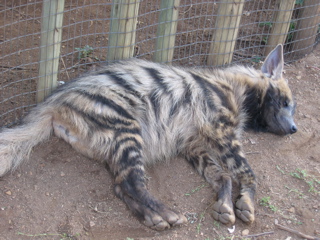Striped hyaena: Difference between revisions
imported>Ro Thorpe m (→Diet) |
imported>Caesar Schinas m (misused credit line) |
||
| Line 16: | Line 16: | ||
}} | }} | ||
[[Image:striped hyaena juvenile.jpg|thumb|right|400px|A juvenile '''striped hyaena''', (''Hyaena hyaena''). | [[Image:striped hyaena juvenile.jpg|thumb|right|400px|A juvenile '''striped hyaena''', (''Hyaena hyaena'').]] | ||
The '''striped hyaena''' ''Hyaena hyaena'', is the least known member of the hyaenid family, smaller than either the [[brown hyaena]] or the [[spotted hyaena]]. | The '''striped hyaena''' ''Hyaena hyaena'', is the least known member of the hyaenid family, smaller than either the [[brown hyaena]] or the [[spotted hyaena]]. | ||
[[Image:Striped hyaena (Hyaena hyaena) laying down.jpg|right|thumb|350px|Striped hyaena (Hyaena hyaena) laying down. | [[Image:Striped hyaena (Hyaena hyaena) laying down.jpg|right|thumb|350px|Striped hyaena (Hyaena hyaena) laying down.]] | ||
==Description== | ==Description== | ||
Revision as of 09:11, 6 June 2009
| Hyaenas | ||||||||||||
|---|---|---|---|---|---|---|---|---|---|---|---|---|
| Scientific classification | ||||||||||||
| ||||||||||||
| [[taxon|Subfamilies and Genera]] | ||||||||||||
The striped hyaena Hyaena hyaena, is the least known member of the hyaenid family, smaller than either the brown hyaena or the spotted hyaena.
Description
The striped hyaena Hyaenidae is 1.2-1.5 m in length, with the tail being between 25 and 35 cm, and stands approximately 70 cm at the shoulder. Adults weight 40-55 kg, with variation between the subspecies. In Israel the mean weight for males was recorded to be 33.6 kg and females were 30.7 kg.[1] [2] Males are typically larger, with both sexes having a very distinctive ‘hyaena’ stature, that being high at the shoulders and lower in the hindquarters. The striped hyaena has very distinctive black and white striping and can erect the hair from the mane al the way back to the tail when to make it appear larger when threatened. The ears are very large and pointed. The muzzle and throat area are typically black in colour. The stripes cover the majority of the body and continue down the legs. It is not known whether the leg stripes can be used to identify individuals as has been recently discovered with brown hyaenas. Five subspecies of striped hyaena have been described.
Behaviour
The striped hyaena is usually sited only at night and tends to forage alone or in pairs. [1]. Females give birth to 2-4 cubs in either modified burrows or natural cave dens [1]. Not a lot is known about striped hyaena behaviour throughout their range. Research done in Israel shows that while mainly nocturnal, striped hyaenas are occasionally seen during the day. It prefers a rocky habitat where it can rest in caves during day time, but at times will take over and modify the burrow of another animal in less rocky areas. Although they primarily forage alone, at times three or more individuals were seen together. They have a suggested home range (calculated by radio tacking) of approximately 300 km2. [2]
Diet
Not an efficient hunter, the striped hyaena is primarily a scavenger and forages a wide range of food from vegetables and fruit to reptiles, birds and mammals. They are capable from scavenging from the largest available prey in the region. They are notable collectors of bone material which they store in their dens, the make-up of which are indicators of the other species and relative abundance of said species inhabiting the environment at the time of collection.
Geographical distribution
The striped hyaena has the broadest range of all the Hyaenid. In the wild, it is found from northern Tanzania to Morocco and across North Africa through out the Middle East and into India.
Status
Listed as low risk or threatened by IUCN.

